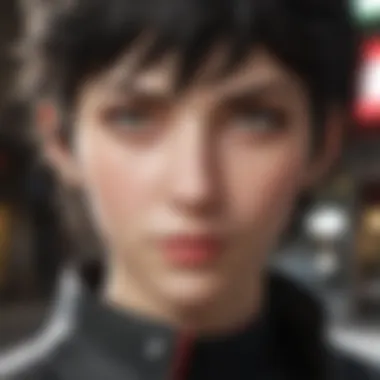Exploring Persona 5: The Animation Dub on Hulu


Intro
The world of anime has grown significantly, with various genres captivating audiences globally. Among this vast landscape, Persona 5: The Animation Dub stands out, available for streaming on Hulu. This anime adapts the popular video game Persona 5, bringing its unique storyline and characters to life in a new way.
Understanding this adaptation involves examining its origin and how it resonates with fans and new audiences alike. Given the depth of the source material, the anime raises questions about how faithfully it retains the spirit of the original game while also creating a standalone experience.
In this article, we will delve into the details of Persona 5: The Animation Dub, analyzing its roots, exploring key characters and themes, and assessing the impact of its English dub adaptation on the viewer experience.
Overview of the Game
Before diving into the anime itself, understanding its origins begins with the game that inspired it.
Game Title: Persona 5
Release Date: September 15, 2016
Developer: Atlus
Genre: Role-Playing Game, JRPG
The game's innovative blend of life simulation with traditional turn-based combat earned it acclaim. Players engage with a fictional version of Tokyo, balancing their school life, friendships, and combat against supernatural foes. The game's immersive narrative and memorable characters set a strong foundation for adaptation into an animated series.
Storyline Analysis
The anime takes cues from the game in terms of narrative, but there are certainly elements that can be explored further.
Plot Summary
The story follows a group of high school students known as the Phantom Thieves of Hearts, who aim to change the hearts of corrupt adults in society. Their adventures lead them to supernatural realms, where they face manifestations of people's desires.
Characters
Each member of the Phantom Thieves brings a unique background and personality to the team. Mediating their struggles, friendships, and growth forms the emotional core of both the game and the anime.
Pacing
The pacing of the anime adaptation has been a topic of discussion. Some fans feel that the anime condenses certain plot points, affecting character development. The transition from game to animation involves sacrificing some details, which can impact storytelling.
Narrative Depth
The anime showcases the same depth in themes present in the game, including rebellion, self-identity, and the complexities of human emotion. This thematic resonance often appeals to both long-time fans and newcomers.
Community Impact
The impact of Persona 5: The Animation Dub extends beyond its critical reception.
Popularity Trends
The release of the dub on Hulu attracted attention from wider audiences, contributing to discussions on platforms like Reddit. The show's presence often rekindles interest in the original game.
Updates and Patches
For fans of the game, patches and updates to the animated adaptation can change perceptions. Any alterations to voice acting or character portrayal will influence discussions in the community.
Competitive Scene
Anime based on popular games often finds a competitive scene where fans engage in debates over adaptation choices. The ongoing discussions enhance community involvement and critical analysis.
End
"The adaptation captures the essence of the original while presenting its story for both seasoned fans and those new to the franchise."
This nuanced perspective invites ongoing dialogue about how anime can reinterpret existing narratives while remaining engaging and relevant.
Prelude to Persona 5: The Animation
The exploration of Persona 5: The Animation marks a notable contribution to the anime landscape, particularly as it expands upon the beloved game from which it originates. This introduction dives deep into the essence of the show, setting the stage for analysis of its many facets from narrative depth to character development. Understanding the anime's significance allows viewers to grasp not only its place within the franchise but also its impact on anime as an evolving medium.
Overview of the Series
Persona 5: The Animation is an adaptation based on the critically acclaimed role-playing game Persona 5. The series follows Ren Amamiya, a high school student who leads a double life as a member of the Phantom Thieves of Hearts. The plot intricately weaves themes of rebellion and social justice, as the characters strive to change the hearts of corrupt adults. The animation captures the aesthetic and tone of the game, utilizing vibrant visuals and energetic soundtracks that resonate with fans.
The anime maintains the core story arcs found in the game yet condenses the narrative to fit the episodic format. It introduces viewers to a cast of engaging characters, each with distinct traits and backstories that contribute to the overall narrative. The series runs for 26 episodes, providing a comprehensive look at the character's journey through their high school life and their battles in a supernatural realm known as the Metaverse.
Transition from Game to Animation
The transition from Persona 5 game to its anime adaptation involves several key considerations. Firstly, the developers had to decide which content to retain and which to omit. Unlike the game, where players have the autonomy to explore relationships and side quests, the anime is succinct. It offers a streamlined narrative that focuses primarily on the main story arcs while sacrificing some of the depth present in gameplay.
Adaptations often face the risk of alienating existing fans if the essence of the source material is lost. Successful adaptations, however, manage to encapsulate essential elements that resonate with both new audiences and established fans. Persona 5: The Animation attempts to balance these expectations, crafting a narrative that aligns closely with the game's themes of rebellion and personal growth.


"Adapting a beloved game into a television series requires a nuanced understanding of its core elements to ensure it remains faithful while still being entertaining as a standalone piece."
The anime also tackles localization challenges by ensuring that cultural references do not get lost in translation. This consideration is crucial for its reception, especially on a platform like Hulu where international viewers can experience the series. In this context, the adaptation serves not just as a reimagining, but as a bridge connecting various audiences to the complex themes of Persona 5.
The Hugely Popular Game Franchise
The Persona 5 franchise has established itself as a notable presence in the gaming world, transcending its origins to become a cultural phenomenon. As this article explores Persona 5: The Animation Dub, understanding the significance of the game franchise is crucial. It provides context for the anime adaptation, enriches the viewer's experience, and reveals why the series resonates with so many.
Historical Context
Persona 5, developed by Atlus, was released in September 2016. It was the latest installment in the long-standing Persona series, which is a spin-off of the larger Shin Megami Tensei franchise. The game was groundbreaking for its elaborate storytelling, unique art style, and complex character development. The series had already garnered a loyal fanbase, but with Persona 5, Atlus achieved something exceptional. In a world saturated with RPGs, this game offered a fresh take, combining traditional elements with modern themes.
The historical significance of Persona 5 can be observed through its deep exploration of sociopolitical issues such as systemic corruption and youth rebellion. This resonated not only with players in Japan but globally. The timing was also relevant, as discussions around these themes were gaining traction in various societies, making the game's narrative timely and impactful.
Critical and Commercial Success
The critical reception of Persona 5 was overwhelmingly positive. Reviewers praised its rich narrative, character dynamics, and gameplay mechanics. The game received several awards, including Game of the Year from multiple gaming outlets, further solidifying its reputation. This success extended beyond traditional gaming reviews, with players engaging in discussions about the game's themes and characters across various platforms, notably on Reddit and other forums.
Commercially, Persona 5 was a triumph. It sold millions of copies worldwide, making it one of the best-selling titles in the Persona franchise. The game's popularity has created a demand for further adaptations, leading to the anime we are discussing. The connection between the game's success and its animated counterpart emphasizes the franchise's ability to engage diverse audiences, reflecting its capacity to adapt and thrive in different media formats.
Different Adaptation of Persona
The transition of Persona 5 from a successful video game to an anime format is a significant topic. This section details how the adaptation affects storytelling, audience experience, and community engagement. Understanding the differences sheds light on the improvements and shortcomings that can arise in such processes.
Anime vs. Game
Each medium brings its own strengths to the table. The game format of Persona 5 utilizes interactive gameplay mechanics, allowing players to shape their own experience. Players delve into the rich world of Tokyo, form relationships, and make choices that influence the narrative progression. This agency becomes central to its allure, tying players closely to the characters and the plot.
In contrast, the anime adaptation takes a more straightforward narrative approach. It focuses on conveying the storyline through visual and auditory elements. This can sometimes lead to a loss of depth in character development, as interactivity is sacrificed. Still, the anime showcases the aesthetic brilliance of the game's art style and the vibrant character designs, bringing the world of Persona 5 to life in a different dimension. The adaptation aims to encapsulate the core themes and arcs without needing the same level of player involvement.
Narrative Structure
The narrative in the anime retains the main plot points of the game but presents them with a specific structure. In the game, players experience multiple story arcs interwoven with gameplay, while the anime simplifies these arcs for a more linear viewing experience. This invites some criticism, as fans of the game might find that certain details or character development moments are glossed over or omitted entirely. However, the anime still manages to highlight several key moments, such as the formation of the Phantom Thieves and their moral battles against societal injustice.
The pacing is another factor to consider. While the game allows for a more relaxed exploration filled with side activities, the anime condenses the narrative to fit a standard runtime. This can streamline the storytelling but also rush critical moments that fans of the game cherish.
In summary, the adaptation from game to anime demands careful thought. Different storytelling techniques arise based on the unique possibilities of each medium. Understanding these differences enriches the viewing experience of Persona 5: The Animation and offers insight into how narrative can shift in the hands of different formats.
Understanding the Dub Adaptation
The dub adaptation of Persona 5: The Animation plays a crucial role in making the series more accessible to audiences who prefer English-language content. Dubbing allows fans who may not be familiar with Japanese audio to engage with the characters and story without substantial language barriers. The significance of this aspect expands beyond mere language conversion; it involves the transformation of cultural nuances and character portrayals that resonate with a diverse viewer base.
Casting Choices
The voice cast selection for the dub is vital to how characters are perceived. Each actor brings their unique style and interpretation to their roles. For Persona 5: The Animation, the choice of voice actors is particularly notable. The primary protagonist, Ren Amamiya, is voiced by Xander Mobus, whose delivery encapsulates the character's complexity. Each member of the Phantom Thieves, including characters like Ann Takamaki and Ryuji Sakamoto, is also assigned talented voice actors that balance emotional depth with engaging delivery.
Casting choices impact the overall tone of the show. Well-chosen actors can enhance character relationships and create a stronger emotional connection with the audience. This is essential in a series that heavily focuses on themes of friendship and trust. The dynamic between characters becomes more vivid through the unique personalities of the voice actors.
Localization Challenges
Localization presents unique challenges when adapting content from Japanese to English. The original dialogue often contains cultural references that may not translate seamlessly. Thus, the localization team must carefully consider how to adapt jokes, idioms, or thematic content while staying true to the source material. For Persona 5: The Animation, this includes ensuring that the humor remains intact and that character motivations are clear in the English version.
Additionally, the pacing of dialogue can differ significantly between languages. Adjustments may be necessary to ensure that the flow of conversation feels natural in the dub. The challenge lies in maintaining the essence of characters' personalities while making their dialogue relatable to English-speaking audiences. This can require significant creativity and understanding of both cultures to ensure fidelity to the source while making it engaging for new viewers.
"Localization is not just about translating words; it’s about conveying cultural context and emotional intent."
In summary, understanding the dub adaptation of Persona 5: The Animation is essential for appreciating how the series reaches a broader audience. Through thoughtful casting choices and addressing localization challenges, the English dub aims to capture the original's spirit while making it accessible to those unfamiliar with the Japanese language.
Key Themes in Persona 5: The Animation
In Persona 5: The Animation, themes are not merely background elements; they are central to understanding the narrative and character motivations. Through various episodes, the series delves deeply into human experiences, reflecting societal issues and personal dilemmas. The key themes of rebellion, friendship, trust, and identity are intricately woven into the story, creating a rich tapestry that resonates with viewers. These concepts foster engagement and encourage reflection, making the anime more than just entertainment.


Rebellion and Justice
Rebellion is a defining theme in Persona 5: The Animation. The main characters, known as the Phantom Thieves, embody the struggle against oppressive societal structures. Their mission is clear: expose corruption and bring justice to those who misuse power. The series critiques authority figures who fail to act in the public's interest, resonating with a viewer base that often feels marginalized or unheard.
Through the actions of Ren Amamiya and his friends, the narrative critiques broader social issues like inequality and abuse of power. These themes of rebellion echo a desire for justice, making the series relatable to audiences disillusioned by real-world injustices. This connection heightens the emotional impact of the story. Each heist undertaken by the Phantom Thieves serves not only to advance the plot but also to underscore this pervasive yearning for a more just society.
Friendship and Trust
The bonds of friendship among the protagonists serve as a foundation for much of the narrative. Trust is pivotal for their collaboration and success as Phantom Thieves. Each character brings unique skills and perspectives to the group, illustrating the importance of mutual support and understanding.
Their relationships evolve throughout the series, highlighting the significance of loyalty and camaraderie. These dynamics are not just for plot development; they reflect broader themes of companionship that resonate in both anime and real life. The series demonstrates that true strength lies in the connections we forge with others, contrasting sharply with the isolation often felt by individuals dealing with personal struggles.
Identity and Self-Discovery
Identity plays a crucial role in the development of the characters. Each member of the Phantom Thieves grapples with their past and self-perception, embarking on journeys of self-discovery. Ren Amamiya, the protagonist, faces the challenge of defining his identity amidst societal expectations and personal traumas.
As they confront their fears and insecurities, viewers witness transformative arcs that emphasize the importance of self-acceptance. This theme resonates particularly with younger audiences who are navigating their own identities. The show encourages introspection and awareness, prompting viewers to question their own values and beliefs.
"In a world where individuals often wear masks to meet societal expectations, Persona 5: The Animation reminds us of the power in understanding and embracing our true selves."
Overall, Persona 5: The Animation addresses complex themes that invite deep reflection. Through rebellion, friendship, and identity, the series connects with viewers on multiple levels, enriching their viewing experience while providing commentary on real-life societal challenges.
Character Analysis
The importance of character analysis in understanding Persona 5: The Animation Dub cannot be overstated. This section unveils layers of complexity within the series, emphasizing how individual motivations drive the overall narrative. Each character, from the protagonist to the antagonists, offers insights into the thematic depth of the story. This exploration assists viewers in engaging more deeply with the material, providing context that enriches their viewing experience. An astute examination of characters fosters a greater appreciation not only for the characters themselves but also for the creative choices made by scriptwriters and animators.
Protagonist: Ren Amamiya
Ren Amamiya, the main character of Persona 5: The Animation, is pivotal to the storyline. As the leader of the Phantom Thieves, Ren embodies the themes of rebellion and self-discovery. His backstory involves transferring to a new school after a past incident of injustice. This trauma informs his desire to challenge societal norms and fight against corruption.
Ren's character development is gradual and nuanced. Throughout the series, he grows from an uncertain teenager grappling with his identity to a decisive leader who inspires others. His abilities to connect with companions underscore the importance of friendship in their collective quest for justice. Ren is not simply a hero; he is a mirror reflecting the struggles of those around him.
The Phantom Thieves
The Phantom Thieves, Ren's companions, collectively represent a diverse set of ideals and personal challenges. Each member has unique attributes that contribute to the group's dynamics and mission.
- Ann Takamaki: She brings strength and compassion, motivated by her desire to protect those who are vulnerable.
- Ryuji Sakamoto: His bravado conceals a deep-seated sense of loyalty to his friends.
- Morgana: A mysterious character, Morgana acts as both guide and comic relief, emphasizing themes of identity.
Their relationships and shared experiences are vital to understanding the series. The camaraderie illustrates how friendship can be a source of empowerment, particularly in the face of adversity. The development of each character, alongside the group, showcases varying perspectives on justice and morality in a flawed world.
Antagonists and Their Motivations
The antagonists in Persona 5: The Animation are equally significant to the narrative. They provide the conflict necessary for character growth and serve as representations of societal flaws. Notable villains include:
- Kamoshida: A emblem of abuse of power, his actions serve as a catalyst for the Thieves’ journey.
- Madarame: He symbolizes the darkness of artistic exploitation, which resonates with Ren and his crew.
Understanding the motivations behind these characters reveals the underlying societal critiques present in the series. Each antagonist acts as a foil to the protagonists, manifesting themes of corruption and moral ambiguity. Their presence challenges not only the Thieves but also the viewers to reflect on the nature of justice and redemption.
"Character dynamics are central to storytelling, as they provide depth and create relatable narratives that resonate on multiple levels."
Analyzing these characters adds depth to the understanding of Persona 5: The Animation. It connects viewers to the larger themes of resistance and personal growth, reinforcing the series as a significant cultural artifact.
Reception of the Dub on Hulu
The reception of the dub of Persona 5: The Animation on Hulu plays a vital role in understanding its overall impact and the way it is perceived by audiences. Dubbed anime often sparks debates among fans regarding the translation of voice acting, cultural nuances, and the adaptability of the story to different languages. Understanding these aspects helps to shed light on the broader landscape of anime viewing and how adaptations can vary in appeal.
Critical Response
Critics have generally held a mixed to positive view of the dub for Persona 5: The Animation. Reviews often focus on the quality of voice acting and the effectiveness of localization. Voice actors such as Xander Mobus, who plays Ren Amamiya, have been praised for their ability to convey the characters’ emotions. Critics have also noted the key differences between the English dub and the original Japanese version.


One important thing is how localization decisions can impact viewer understanding. Some phrases and cultural references may not directly translate well, which can change the experience for English-speaking audiences. Critics recognize that while certain adaptations may lack cultural depth, the English voice cast manages to deliver compelling performances that resonate with fans. In summary, the criticism highlights both strengths and weaknesses, creating a rich field for discussion among anime fans.
Viewer Ratings and Feedback
When it comes to viewer ratings, Persona 5: The Animation Dub has seen notable engagement on Hulu. Many viewers appreciate the effort put into the English adaptation. User reviews frequently emphasize that the voice acting fits the vibrant style of the animation.
Although some viewers still prefer the original Japanese dub, ratings show a strong acceptance of this adaptation. Feedback on platforms like Reddit often indicates that the dub allows new fans to enter the franchise without the barrier of subtitles, which can be particularly important for those unfamiliar with anime.
"The English dub of Persona 5 helped me connect with the story in a way that I didn’t anticipate." - Viewer Comment on Reddit
Comparative Analysis: Dub vs. Sub
The discourse surrounding the comparison of dub and sub formats in anime is pivotal in understanding how audiences receive and interpret a series like Persona 5: The Animation. Both versions offer distinct experiences, often influenced by the viewer's preferences for language, cultural context, and artistic interpretation. Some fans favor the original Japanese audio and subtitles, while others appreciate the localization present in the English dub.
The importance of this analysis lies in its potential to enhance the viewing experience. By addressing the strengths and weaknesses of each format, we facilitate a deeper understanding of how adaptation choices affect audience reception. Key considerations include voice acting quality, translation fidelity, and the emotional depth conveyed through audio-visual elements. This balance is crucial in determining which version resonates more effectively with viewers.
Artistic Interpretations
When examining Persona 5: The Animation, artistic interpretations differ significantly between the dub and the sub. The English dub often aims to retain the essence of characters while adapting dialogue for cultural relatability. Voice actors in the English dub, like Xander Mobus as Ren Amamiya, bring their own nuances to the character's portrayal. Adjustments in tone, pacing, and delivery can affect how humor, seriousness, and emotional weight manifest in the narrative.
In contrast, the subbed version relies on the original Japanese performances. This can provide a level of authenticity in character expression. Fans who prioritize the creator's intent may prefer this version, as the nuances in cultural language often reflect deeper emotional contexts. Subtle inflections in voice can evoke feelings that localized humor might not capture.
Cultural Nuances in Translation
Cultural nuances pose significant challenges in the translation process from Japanese to English. Certain phrases, idioms, or references may not have direct equivalents in English. The adaptation teams face the dilemma of remaining faithful to the source material while making it accessible and enjoyable for an English-speaking audience.
The English dub often incorporates cultural references familiar to Western audiences, which can create a different tone or implication than the original. For instance, specific social cues or humor may shift when stripped from its original context, leading to a reinterpretation of character interactions. The challenge remains: how much of this cultural content needs alteration to maintain relevance for audiences without losing the series' essence?
"Effective localization should facilitate understanding without diminishing the original's culture."
This ongoing challenge has implications beyond just the narrative at hand. It speaks to the broader discussions around anime's growth in the global market, where viewers expect a connection with the source, yet also engage with their own cultural interpretations of the material. Balancing these is crucial for the future of anime distributions and adaptations.
The Role of Streaming Services in Anime Distribution
Streaming services have significantly transformed the anime landscape in recent years. Platforms like Hulu, Crunchyroll, and Funimation have changed how audiences access animated content. This evolution is especially crucial for series like Persona 5: The Animation, which thrives in a digital-first environment. The convenience and immediacy provided by these services encourage viewers to explore not just the latest releases but also older titles.
Impact on Accessibility
With the rise of streaming services, access to anime has never been easier. Viewers can now find a vast library of content at their fingertips. No longer do fans need to rely on physical media or scheduled broadcasts. Instead, they can watch entire series on demand, which significantly broadens the audience base for shows like Persona 5: The Animation.
The enhanced accessibility caters to varied viewer preferences. For instance, fans who prefer dubbed versions can easily switch languages on platforms like Hulu. This flexibility allows people who may not be comfortable with subtitled content to enjoy the series fully. Moreover, the availability across devices—smartphones, tablets, and smart TVs—ensures that viewers can watch on the go or in the comfort of their homes.
Trends in Viewer Preferences
As streaming services dominate anime distribution, viewer preferences shift accordingly. Many audiences now favor binge-watching entire seasons rather than watching weekly episodes. This trend stems from the desire for continuity and immersion in the storylines, particularly for series with intricate narratives like Persona 5: The Animation.
Additionally, viewers are becoming increasingly discerning about quality. This statement includes attention to animation quality, voice acting, and the fidelity of story adaptation. Services that provide high-definition streams and multiple language options will likely attract more viewers, solidifying their user base. With this, the demand for high-quality adaptations and diversely dubbed content has surged.
"Streaming has bridged the gap between cultures, allowing Western audiences to engage with Japanese storytelling in new ways."
In summary, the role of streaming services in distributing anime shapes viewer access and consumption habits. Understanding these dynamics is particularly vital for fans and new viewers of Persona 5: The Animation, as they navigate this enriching media landscape.
Culmination and Future Prospects
In wrapping up this examination of Persona 5: The Animation Dub, it becomes clear how significant this series is within both the anime realm and gaming culture. The anime adaptation, particularly the English dub available on Hulu, holds a pivotal position by providing accessibility to a wider audience. This bridging of cultures and languages enhances the overall experience, ensuring that fans of the original game do not miss out on essential nuances available in the animation.
Legacy of Persona
The legacy of Persona 5 and its adaptation is multifaceted. The original game has set a benchmark for narrative depth in role-playing games, combining elements of strategy, relationships, and personal growth. The animation further extends this legacy by visualizing core themes such as rebellion against societal constraints and the quest for identity. Such themes resonate profoundly with viewers, especially younger generations navigating their own challenges in a complex world.
This narrative not only entertains but also provokes thought, leading some fans to engage further with philosophical discussions inspired by the series.
Moreover, the artistic direction in the animation leaves a lasting impact. The distinctive art style mirrors the game's vibrant aesthetics and character designs, prompting discussions about visual representation in anime adaptations. The characters' arcs are deftly illustrated, lending themselves well to a visual medium, thereby appealing to those who may not have experienced the game.
Potential for Future Adaptations
Looking ahead, there exists a significant potential for further adaptations related to Persona 5. The franchise is built upon a rich narrative universe, making it ripe for additional exploration in various formats. The ongoing popularity of the series could lead to new story arcs, side stories, or even spin-offs. Creative teams could delve deeper into narratives that have been less explored in both the game and animation, such as specific character backstories.
Additionally, with streaming platforms like Hulu paving the way for diverse content, the opportunity for innovative adaptations expands. Animated features, live-action interpretations, or even mini-series could thrive in this environment. The challenge will be to maintain the essence of what makes Persona 5 compelling while also adapting to the preferences of an evolving audience.
Adaptations could also explore cross-cultural narratives, introducing Persona 5 to new audiences who may be less familiar with the theme-based intricacies of Japanese storytelling.



